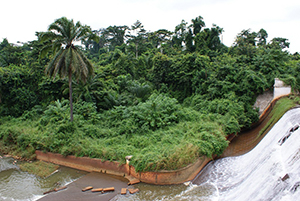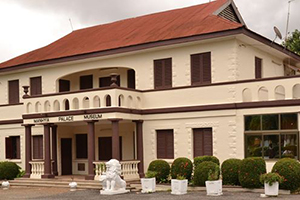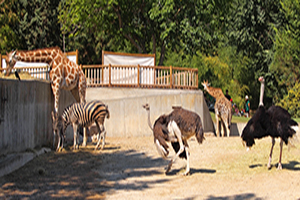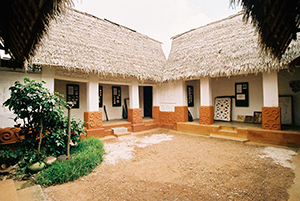Tour Packages - Ashanti Region Tours

Owabi Wildlife Sanctuary

Manhyia Palace Museum

Kumasi Zoo

Asante Traditional Building
Visit will include
- - Manhyia Palace
- - Center for National Culture
- - Ghana Armed Forces Museum
- - The Rattray Park
- – The Prempeh II Jubilee Museum
- – Royal Mausoleums
- – Lake Bosomtwe
- – Ashanti Temples & Shrines
- – Kumasi Zoo
- – Owabi Wildlife Sanctuary
- – Kogyae Nature Reserve
- – Bobiri Forest Reserve & Butterfly Sanctuary
- – The Atwea Mountain
- – Ashanti Goldfields
- – The Crafts of the Asantes
- – Adanwomase Kente Villiage
- – Asuofia Asamang
- – Mframabuom Caves
Sample Itinerary
- (10 Days / 9 Nights)
Day 1. Arrival in Ghana.
Day 2. Travel to Kumasi
Day 3. Manhyia Palace
Day 4. Kumasi Central Market
Day 5. The Rattray Park
Day 6. Royal Mausoleum & Museums
Day 7. The Ashanti Temples & Shrines
Day 8. The Atwea Mountain
Day 9. Shopping
Day 10. Free Day & Departure in the Evening
ASHANTI REGION
Ashanti Region Thank you for taking interest in travelling to Ashanti Region “the cultural heartbeat of Ghana”. The picturesque and undulating Kumasi is the regional capital, the second largest city in Ghana and is about 150 miles inland from the Gulf of Guinea.
The Asantes (Ashantis) constitute the largest of the various subgroups of the Akan, who trace their origins partly to Bono-Manso and Techiman, in present-day Brong Ahafo Region. The Asante kingdom was founded by the great King Osei Tutu in the eighteenth century. His fetish priest, Okomfo Anokye unified the Asante states through allegiance to the Golden Stool, which miraculously descended from heaven. Okomfo Anokye planted two trees in the forest and predicted that one tree would live and become the capital of Ashanti. Hence, the name Kumasi (the tree that lived); the place in which the other tree was planted became Kumawu (the tree which died).
Although located in the heart of the forest, Asante dominion was extended by military action and political skill towards the European occupied castles on the coast to the south, and also into the dry savannah lands to the north. This led to various wars with Britain. Kumasi was captured by the British Army in 1873 (as a result of which much of the magnificent Asante gold regalia can be seen in London in the British Museum). After a final uprising in 1901, led by the Queen Mother of Ejisu (Nana Yaa Asantewaa).
Asante came into British protection and finally became a region of the Gold Coast colony. In 1957, after a period of internal self-government, the Gold Coast became the first African colony to achieve independence under the charismatic leadership of Kwame Nkrumah. The Ashantis often call their homeland Asante. The name Ashanti is an English language pronunciation misnomer for the Ashanti people. The Ashanti ethnic group is pronounced Asantefoↄ in Ashante language. Asanti literally means “because of wars” (Asa – wars; Nti- because [of]. Nana Yaa Asantewaa Queen Mother of Ejisu.
Location and Size Ashanti Region is located in the middle belt of Ghana occupying a total land surface of 24,389 km2 (9,417 sq m) situated on the semi-island exclave Ashanti land. The indigenous people of Ashanti (Ashanti region) are known as Asantes. The region occupies 10.2% of the total land area of Ghana and is the third largest of 10 administrative regions. It lies on longitude 0.15W and 2.25W, and latitudes 5.50N and 7.46N.
BOUNDARIES / POPULATION
The region shares boundaries with four of the ten political regions, Brong-Ahafo in the north, Eastern region in the east, Central region in the south and Western region in the South west. It is the most populous region in Ghana with a population of 4,780,380 accounting for 19.5% of the country’s total population (2010 population census).
TOPOGRAPHY, CLIMATE AND VEGETATION
The region has an average annual rainfall of 1270mm and two rainy seasons. The rainy season starts in March, with a major pick in May so tourists are encouraged to carry along raincoats and umbrellas to save them from the severe outpouring of the rains. There is a major rainy season in June to July and a pick in August, tapering off in November.
December to Febuary is dry, hot, and dusty. The average daily temperature is about 27 degrees Celsius. Much of the region is situated between 150 and 300 meters above sea level. Humidity in Ashanti Region is relatively high, averaging about 85% in the Ashanti forest area and 65% for the Ashanti savannah belt.
The region is endowed with a spectacular geography: lakes, scarps, forest reserves, waterfalls, national parks, birds and wildlife sanctuaries.
ECONOMIC ACTIVITIES
The Ashanti Region is largely driven by the export of gold, manganese ores, bauxite, timber and agricultural commodities such as cocoa and yam. The aerospace with automotive manufacturing and repair of motor vehicles and motorcycles (25.2%), manufacturing (10.5%), other service activities (6.3%) and accommodation and food service activities (6.0%).
The Kumasi Central Market which is the popular market is where most commercial activities take place. All the towns in Ashanti have their local markets. The major occupation in all the districts is Agriculture, Animal Husbandry, and Forestry except in the Kumasi Metropolis where sales workers predominates.
Majority of the economically active population are self-employed, mainly in the Private informal sector which provides job opportunities.
The Kumasi Central Market
Administration The King of the Ashantis is Otumfuo Osei Tutu II. The social administration in Ashanti is through a traditional system of chieftaincy. The Ashanti region has 30 administrative Metropolitan, Municipal and District Assemblies (MMDAs).
The Regional Minister acts as the Chairman of the Ashanti Regional Coordinating Council. Other members of the Ashanti Regional Coordinating Council include the Ashanti Regional Coordinating Director (Secretary), all the 30 Metropolitan Municipal District Chief Executives and Presiding members, as well as two representatives from the Ashanti Regional House of Chiefs. All Ashanti Regional heads of department are ex-officio members of the Ashanti Regional Coordinating Council.
CULTURE
The Ashanti tribe is one of the few matrilineal societies in West Africa. The Ashantis are most famous today for their craft work, particularly their hand-carved stools, fertility dolls and their colourful kente cloth. They are blessed with rich culture, and a home to pomp and pageantry. The region is also known for its historical and mythical landmarks.
The main dishes of Ashantis include fufu with light soup, or “abunu abunu” (green soup) or palm nut soup, ampesi (plantain, yam, cassava, cocoyam). Adowa, Kete and Nwomkoro are the traditional dances of the Ashantis and the renowned one is the Adowa.
The Adowa is performed by people dressed in fine apparel especially the kente cloth. It is danced at major events, ceremonies, festivals, funerals and so on. There are other tribes who have migrated from their regions and are dispersed all over the region.
The Ashantis are known to be very hospitable, so they have designated areas to these tribes where one can find most of them and have a feel of their culture.
HEALTH
There are about 550 hospitals and health facilities in the region with Komfo Anokye Teaching Hospital as the regional hospital.
SAFETY AND SECURITY
Ashanti region is regarded as one of the safest regions in Ghana. There are other private security agencies that complement the effort of the Police, Military, and Fire Service in maintaining safety and security in the region.
MAJOR FESTIVALS IN ASHANTI REGION
Festivals are a demonstration of traditional values, dressing, music and dance. The following are the major festivals celebrated in the Ashanti Region.
Festivals Period/Date Towns/Districts Significance
Akwasidae – Once every six weeks from the date of the previous event. Asantehene and the Asante kingdom celebrate this festival, which serves as the platform for pledging allegiance to the kingdom and affirming loyalty to the golden stool.
Kente in the month of August in Bonwire, (Ejisu-Juaben)- Commemorates the origin of the Kente cloth, Bonwire, over 300 years ago. The festival also seeks to assert the influence of the Kente as an exclusive cloth from this part of the world.
Yaa Asantewaa In the August in Ejisu, (Ejisu-Juaben)-To commemorate the bravery of heroine Yaa Asantewaa I, for resisting attempts by the British Forces to capture the Ashanti Golden Stool by leading the famous uprising in the late 1690’s.
Nkyidwo November Essumeja, Ashanti Region-Celebrated on the last Monday in November or the first Monday of December at Essumeja in the Ashanti Region. It is a festival which marks the emergence of the first seven Ashanti ancestors from a huge hole in the ground.
Mmoa Nni Nko in the month of October in Offinso - To celebrate the bravery and wisdom of Nana Wiafe Akente I, who chose a large piece of land instead of jewelry, when the King was rewarding the various divisions after war against the Dormaas of the Brong Ahafo region, which the Ashantis won.
Papa in the month of March in Kumawu, (Sekyere East)- The festival reminds the chiefs and people of the Kumawu traditional area of the bravery of their ancestors, especially, Nana Tweneboah Kodua I, who offered himself as ransom in order that the Ashantis emerged victorious in the battle of independence fought against the Denkyiras. The festival also seeks to purify the state by driving off evil spirits, which may hinder the search for elephant tusks, which are important paraphernalia of the royalty.
EVENTS
Lake Fiestas on Public Holidays at Lake Bomsotwi – General merry-making at the lakeside. Games, entertainment, food and drink.
Ashanti Funerals on Saturdays Kumasi and other towns. Spectacular events for seeing off the dead. Kumasi Attire is generally red or black in colour.
World Tourism Day 27Th September
TOURIST SITES IN THE ASHANTI REGION
Ashanti region is blessed with many Attractions be it natural or historical which people across the length and breadth of the country wish to travel for recreation, leisure, education or business purposes.
THE MANHYIA PALACE MUSEUM/OKOMFO ANOKYE SWORD
The seat of the Ashanti King which houses a Royal Museum stocked with unique paraphernalia and life-size statues of notable Ashanti Kings and Queens, as well as a Gift Shop and Art Gallery.
The Manhyia Palace Museum was created within the Old Residence of Otumfuo Agyeman Prempeh I and Otumfuo Sir Osei Agyeman Prempeh II, the thirteenth and fourteenth Kings of Ashanti respectively. This historic building, which was built in 1925, was rehabilitated in 1995.
The Museum was officially opened on August 12, 1995 by Otumfuo Opoku Ware II, the 15th King, as part of activities marking the Silver Jubilee of his ascension to Sikadwa (Golden Stool). Okomfo Anokye Sword.
CENTRE FOR NATIONAL CULTURE
The Centre was built by Dr. A. A. Y Kyeremateng. It is a site which was set up to create a venue for the reinforcement of the Akan culture among the youth. The Centre is located opposite Komfo Anokye Teaching Hospital and shares a wall with the Kumasi zoo.
It is just a five minutes’ walk from the Central market. This is an ideal place to start exploring the region. A cultural performance could be arranged for interested tourists for a fee. Essential information about the region and other parts of the country can be obtained from the Regional Tourist Information Office within the Centre for National Culture.
GHANA ARMED FORCES MUSEUM (KUMASI FORT) # 22, STEWART AVENUE, ADUM, KUMASI:
The present Kumasi Fort was built by the British government in 1897 from a reconstruction of an old Fort built by Asante’s in 1820. The old fort was built by Nana Osei Asibe Bonsu and used as his palace (Nana Bonsu Aban).
He fought the Fante Wars of 1806-07 that took him to the Coast where he saw the castle in Cape Coast. He decided to build a fort like that occupied by his white friends in Cape Coast where he could live like the British Governor of Cape Coast.
He more importantly admired the brown color of the granite used to build the castle in Cape Coast, so he made people carry head loads of granite from the Coast to Kumasi, molded them into bricks for the construction of the fort.
However, it was mined and destroyed by Sir Garnet Wolseley’s expedition in 1873/74. After the arrest and deportation of Asantehene Prempeh I, the British saw the wisdom in the old fort and reconstructed it to the plans of Captain Phillips of the Royal Engineers and named King George’s Fort. The Museum was officially established in 1952 and it was then known as the Gold Coast Regimental Museum.
But due to the tri-service nature of the armed forces in 1959 (Army, Navy, Air-Force), the name was changed to Armed Forces Museum. Now the museum has about 2,000 collections displayed in 10 halls covering Ashanti history, British colonial administration, and the military tradition of Ghana. The museum has a condemn cell where Yaa Asantewaa was detained before she was exiled to the Seychelles Island, and the spot the British kept the Gold weight of Nana Prempeh I.
THE RATTRAY PARK-KUMASI CITY
Welcome to Rattray Park-Kumasi city, a modern-day garden with state-of -the-art recreational facilities and the best of serene natural environment located right in the heart of Kumasi, the “Garden City of West Africa”. The park provides 43,252.18m2 (10.69 acres) of open space located within 2km of the city centre and boasts of an international collection of flora from around the world.
In addition to its purely botanical and floral nature, the park has a huge passive recreation and picnic area and facilities for families, business executives, schools, organized groups and individuals. The park is named after Robert Sutherland Rattray, CBE, known as Captain R. S. Rattray (1881-1938). As an early Africanist and a student of the Ashanti kingdom, he was one of the early writers on Oware and Ashanti Gold weights.
The following features makes the park unique:
• The Beautiful Floral Gardens
• Dancing Fountain
• The Jetty
• Open Gymnasium
• Children playground
• Golf Cart
• Cafeteria
• Wireless Internet
• Parking Spaces
THE PREMPEH II JUBILEE MUSEUM
It is located in the centre for national culture grounds. The museum houses a fascinating collection of Ashanti history such as memorabilia of Okomfo Anokye, including the over 300 years old antique treasure bag which he forbade anyone to open and a picture of the real golden stool which rarely appears in public.
ROYAL MAUSOLEUMS AND MUSEUMS
The final resting place of the Ashanti Royalty (Bantama and Breman) may be visited with consent of the Manhyia palace.
LAKE BOSOMTWE
It is located 31 km southeast of Kumasi. .It is regarded as a sacred water body by the Ashantis. This picturesque Crater Lake is surrounded by dozens of fishing and farming villages. The lake basin is ideal for mountaineering, diving, swimming, fishing, hiking, building and relaxation. Tradition forbids fishing on the Lake on Sundays.
The use of dugout canoes and paddles on the lake is also forbidden. It is by far the most expensive and deepest (90 m) natural fresh water body in Ghana with a surface area of around 25 km. Accessible by road from Kumasi.
THE ASHANTI TEMPLES AND SHRINES
There are several of these and all have interesting things that can make your visit worthwhile.
KUMASI ZOO
Kumasi zoological gardens (Kumasi zoo) was opened as a result of a decision taken in July 1951 by the Asanteman council to preserve Ashanti culture, foster social research and publish journals on Ashanti customs and other matters of general interest.
Currently it holds a modest selection of Ghana’s wildlife. A more remarkable feature of the zoo are the thousands of bats that rest on the trees. It is one of the most exciting, educative and recreational component.
SOME RULES VISITORS MUST OBSERVE
• Do not feed the zoo animals (Spot fine)
• Do not disturb or excite the zoo animals
• Do not stretch your hand or go further than the safety barriers; animals are not tamed.
• Put all litter into the dustbins provided at vantage points throughout the Zoo.
• Do not make noise in the Zoo; Noise is a form of pollution.
OWABI WILDLIFE SANCTUARY
15km North East of Kumasi. An ideal habitat for winter migratory birds and hundreds of endangered Mona Monkeys. Knowledgeable guides are available to assist visitors through this tropical forest along meandering hiking trails around the Owabi River.
THE BOMFOBIRI WILDLIFE SANCTUARY
About 80km north east of Kumasi. The reserve showcases a tropical landscape, vibrant waterfalls and a wide variety of birds and animal life. Assistance and clearance are available at the wildlife division.
BOBIRI FOREST RESERVE AND BUTTERFLY SANCTUARY
About 20km on the Kumasi – Accra highway. A quiet research centre for the Forestry Research Institute showcasing an arboretum, forest hiking trails and a butterfly sanctuary. Guiding and interpretative materials are available.
KOGYAE NATURE RESERVE
Kogyae strict nature reserve is a natural preservation area setup to protect the ecology and promote scientific research particularly on how nature revitalizes itself after major disasters. Historically the area constitutes the sites where the two traditional areas Kumawu and Kwaman, by treaty joined forces to fight invading enemies in one of their last victorious tribal wars.
DIGYA NATIONAL PARK
Occupies 3,478 square kms of undulating terrain on the western shore of the Volta Lake. Made up of predominantly Guinea Savannah woodland and gallery forest along the major rivers, complete with sandstone inselbergs. Has at least six primate species, black and white colobus monkeys, elephants and a variety of antelope species, manatees and clawless otters.
THE ATWEA MOUNTAIN
Located 12 km from Nsuta and 52 km from Kumasi, it offers a beautiful view of Kumasi and the countryside.
MFRAMABUOM CAVES
These caves can be found at Kwamang, 53 km from Kumasi.
ASHANTI GOLDFIELDS
This gold mine is located at Obuasi, 50 km southwest of Kumasi. It is one of the richest gold mines in the world and listed on the Johannesburg, Paris, Brussels, London, New York, Sydney and Ghana stock exchange. It has been merged with the biggest mining company in South Africa, AngloGold to become Anglogold Ashanti Ltd.
THE CRAFTS OF THE ASANTES
A dozen artisanal villages, specializing in a variety of cultural craft items and indigenous textiles are located in the vicinity of Kumasi. These are: PANKRONO 8km on Mampong Road. Renowned for its distinctive and colorful pottery created through tradition processes without the use of the potter’s wheel. AHWIAA 9km on Mampong Road. Specializes in wood carvings such as stools, masks, fertility dolls and linquist staffs. NTONSO 18km on Mampong road.
A settlement of Adinkra textile printers using traditional motifs and symbols which are an expression of religious, political and socio-cultural philosophies of the Asante. BONWIRE Bonwire is the leading town for the production of Kente. A settlement of hundreds of Kente weavers. A wide variety of hand-woven Kente fabrics are obtainable in many of the local shops. 20km on the Antoa Road.
ADANWOMASE KENTE VILLAGE
Strip-weaving has existed in West Africa since the 11th century and the village of Adanwomase has been weaving the cloth known today as Kente since the 17th Century. It has served as the royal weaving village for the Asantehene (Asante King).weavers create customized designs for clients. kente is used in worship and in ceremonies related to birth, marriage and death.
ASUOFIA-ASAMANG
15km south of Kumasi on Barekese Road. Significant for the production of glass bead ornaments. AMPABAME-KROFROM 15km on Old Bekwei road. Specializes in brass casting through the lost-was process. The home of the Ashanti gold weights. ASANTE TRADITIONAL BUILDINGS Unique Ashanti architecture constructed with local materials and decorated with immensely interesting and educative motifs and symbols.
Classical examples of Ashanti traditional buildings/shrines can be found at Kumawu- Bodomase, Edweso, Patakro, Edwenase, Adako-Jachie, Kentinkrono, asenemaso, Saaman and Berem.
BANKS/FOREX BUREAU
Banks and Forex Bureau are found in most of the district capitals dealing in monetary Transactions in cedis and selected foreign currencies. Kwame Nkrumah University of Science and Technology (KNUST) Kumasi Airport.
EDUCATIONAL INSTITUTION
There are about 26 public senior high schools in the Ashanti Region, the Ashanti Region also has one public university the Kwame Nkrumah University of Science and Technology (KNUST) and a polytechnic in Kumasi (KPOLY). In addition, there are a number of private universities senior high schools and colleges spread throughout the region.
NIGHTLIFE
The Ashanti region is vibrant on Fridays, Saturdays and Sundays. People go out to entertain themselves to the beat of highlife, liveband, hiplife, afropop and RnB.
Street bars and pubs line the roads and revelers go into the night in search of a good time, from chic cocktail bars to jam- packed nightclubs.
ACCOMMODATION
Kumasi’s position as Ghana’s second larest city is amply demonstrated in the range of top quality accommodation facilities available to the visitor. From MODEST BUDGET ACCOMMODATION UNITS OFFERING BASIC but clean lodgings to exquisitely furnished small luxury guest houses, full service hotels with casinos, jazz pubs, swimming pools and gyms, the Ashanti Region will meet the needs of every guest.
RESTAURANTS AND LOCAL EATING PLACES
Restaurants and fast food outlets provide both international and Ghanaian dishes. Visitors may sample tasty indigenous Ghanaian meals, indian or Chinese delicacies as well as continental dishes. Local eating places (or chop bars) are found in most parts of the Region.
Go Back


